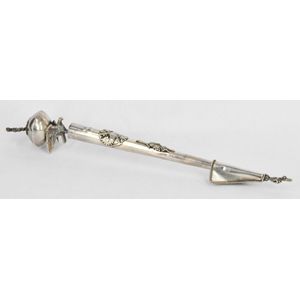Danish Oak Buffet Server with Figural Head Handles
You must be a subscriber, and be logged in to view price and dealer details.
Subscribe Now to view actual auction price for this item
When you subscribe, you have the option of setting the currency in which to display prices to $Au, $US, $NZ or Stg.
- Column - An architectural feature sometimes used for decorative effect and sometimes as part of the supporting construction. Columns should generally taper slightly towards the top. They may be plain or decorated with carving, fluting or reeding. Columns may be fully rounded or, more commonly, half-rounded and attached with glue, screws or pins to the outer stiles of doors, or the facing uprights on cabinets and bureaux.
- Oak - Native to Europe and England, oak has been used for joinery, furniture and building since the beginning of the medieval civilisation. It is a pale yellow in colour when freshly cut and darkens with age to a mid brown colour.
Oak as a furniture timber was superceded by walnut in the 17th century, and in the 18th century by mahogany,
Semi-fossilised bog oak is black in colour, and is found in peat bogs where the trees have fallen and been preserved from decay by the bog. It is used for jewellery and small carved trinkets.
Pollard oak is taken from an oak that has been regularly pollarded, that is the upper branches have been removed at the top of the trunk, result that new branches would appear, and over time the top would become ball-like. . When harvested and sawn, the timber displays a continuous surface of knotty circles. The timber was scarce and expensive and was used in more expensive pieces of furniture in the Regency and Victorian periods. - Foliate - Decorated with leaves or leaf-like forms.
- Reeding - A series of parallel, raised convex mouldings or bands, in section resembling a series of the letter 'm'. The opposite form of fluting, with which it is sometimes combined. Reeding is commonly found on chair legs, either turned or straight, on the arms and backs of chairs and couches and around table edges in the Neoclassical or Classical Revival manner. Reeding was also used as a form of decoration during the Edwardian period, but it is usually much shallower and evidently machine made.
This item has been included into following indexes:
Visually similar items

An 18th century oak coffer, of attractive small proportions, the three panelled hinged lid opening to reveal an interior with candle box to one end, the fascia again with three panels each carved with an astragal trellis and with small raised bosses in the

A Russian-Polish silver torah yad, with lion finial, coat of arm, vine leaf and grape ornaments. By A.K, Warsaw 1867. Length 30 cm. Weight 60g.

An important live steam model of the 'Charlotte Dundas' circa 1870s, approximately 1:24 scale model, of the paddlewheel steamboat, constructed, according to family history, from timbers taken from the actual Charlotte Dundas which was scrapped in 1861, cen

Swarovski Crystal SCS Cinta Elephant, plaque, #1137207, with original box, 11.5 cm high approx.
